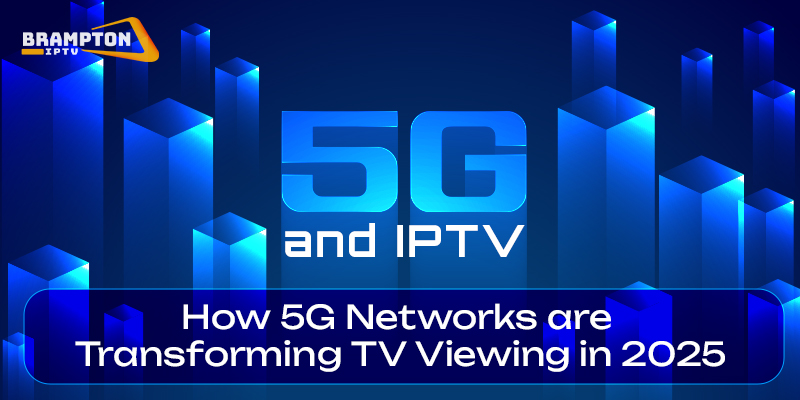
The world of television is undergoing a massive transformation, and at the heart of this change lies the groundbreaking emergence of 5G technology. With its lightning-fast speeds-up to 100 times faster than 4G-and ultra-low latency as minimal as 1 millisecond, 5G is revolutionizing how IPTV (Internet Protocol Television) services are delivered and consumed. IPTV has already been disrupting traditional cable TV, offering users unparalleled flexibility, on-demand content, and access to thousands of channels, including international language channels. In fact, the global IPTV market is projected to grow at a compound annual growth rate (CAGR) of 16.1% from 2023 to 2030, reaching a staggering $194.21 billion by 2030, according to Research.
In this blog, we’ll explore how 5G is transforming IPTV services, the role of IPTV providers, and what this means for your IPTV subscription.
IPTV services allow users to stream television content via the internet instead of relying on satellite or cable connections. This means users can watch their favorite shows on various devices, including smart TVs, smartphones, tablets, and computers. The demand for IPTV providers has been steadily increasing, thanks to the growing number of cord-cutters who prefer internet-based entertainment solutions.
With the advent of 5G, IPTV subscriptions have become even more attractive, offering improved streaming quality, reduced buffering, and seamless access to high-definition and ultra-high-definition (4K and 8K) content. The combination of 5G and IPTV eliminates many of the challenges that users previously faced with unstable internet connections, ensuring an uninterrupted and high-quality viewing experience.
1. Faster Speeds for Seamless Streaming
One of the biggest advantages of 5G technology is its significantly faster internet speeds. While 4G networks offer average speeds of 20-50 Mbps, 5G can provide speeds of up to 10 Gbps. This means users with an IPTV subscription can stream content in real time without experiencing buffering issues, even when watching 4K or 8K videos.
2. Low Latency for Real-Time Viewing
Latency, or the delay between data transmission and reception, has always been a concern for live streaming services. 5G technology significantly reduces latency, making it ideal for live TV streaming, sports broadcasts, and interactive content. IPTV providers leveraging 5G can now deliver near-instantaneous responses, enhancing the experience for viewers who enjoy live events.
3. Enhanced Mobile Viewing Experience
5G technology is designed to support multiple devices simultaneously without compromising performance. This means users can access IPTV services on their smartphones, tablets, or laptops without experiencing network congestion. The rise of mobile IPTV app has made it easier for users to watch TV on the go, and 5G ensures that they get the best streaming experience regardless of location.
4. Improved IPTV App Performance
With better network stability and speed, IPTV apps can now operate more efficiently. Users no longer have to deal with lagging apps, long buffering times, or poor resolution. IPTV app developers are optimizing their platforms to take full advantage of 5G capabilities, offering improved interfaces, faster loading times, and better user experiences.
5. Higher Bandwidth for Multiple Connections
A major benefit of 5G is its ability to support a higher number of connected devices simultaneously. Households with multiple IPTV subscriptions can now stream different channels on various devices at the same time without experiencing slowdowns. Whether it’s watching a sports game in the living room, streaming a documentary in the bedroom, or catching up on the news on a tablet, 5G ensures smooth and uninterrupted viewing.
6. IPTV Support for Virtual and Augmented Reality (VR/AR)
5G is opening doors for new IPTV innovations, including the integration of virtual and augmented reality. IPTV providers are now exploring VR and AR streaming options, allowing users to immerse themselves in a more interactive viewing experience. Imagine watching a sports match from a 360-degree perspective or attending a live concert virtually-5G is making these possibilities a reality.
1. Increased Adoption of IPTV Services
As 5G networks become more widespread, more users are opting for IPTV subscriptions. The improved connectivity makes IPTV a more viable alternative to traditional cable and satellite TV, especially in rural areas where wired connections may be limited.
2. Expansion of Multilingual Content and International Channels
IPTV providers are now able to offer a broader selection of content, including international channels catering to diverse audiences. With higher bandwidth and faster speeds, language-specific channels such as Hindi, Punjabi, Telugu, Tamil, Kannada, Marathi, and others can be streamed in high quality without interruptions. Users who require IPTV support for multiple languages can now enjoy content in their preferred dialect without limitations.
3. Better IPTV Reviews Due to Enhanced User Experience
With reduced buffering, faster streaming, and improved picture quality, users are giving more positive IPTV reviews. The adoption of 5G has significantly enhanced customer satisfaction, leading to better feedback for IPTV providers and greater trust in their services.
4. Competitive Pricing and Flexible Plans
Since IPTV services rely on internet connections rather than expensive cable infrastructure, they are generally more cost-effective. With 5G reducing operational costs for IPTV providers, subscription plans have become even more competitive. Users now have access to a variety of affordable IPTV packages that cater to their viewing preferences.
While the integration of 5G and IPTV is largely beneficial, there are some challenges that need to be addressed:
Despite these challenges, the future of IPTV in the 5G era looks promising. Innovations such as AI-driven content recommendations, smart home integration, and personalized IPTV experiences will continue to enhance user engagement.
5G technology is revolutionizing the IPTV landscape, delivering faster speeds, lower latency, and improved network reliability. IPTV providers are leveraging 5G to offer seamless streaming, high-definition content, and interactive viewing experiences. As more users switch to IPTV subscriptions, the demand for high-quality, multilingual, and diverse content will continue to grow. With advancements in IPTV apps and support for emerging technologies like VR and AR, the future of television viewing in 2025 is more exciting than ever. Whether you’re a casual viewer or a dedicated IPTV enthusiast, 5G is ensuring that your entertainment experience reaches new heights.